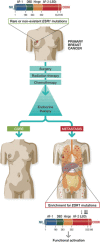Estrogen receptor mutations and their role in breast cancer progression
- PMID: 25928204
- PMCID: PMC4429420
- DOI: 10.1186/s13058-014-0494-7
Estrogen receptor mutations and their role in breast cancer progression
Abstract
Endocrine therapy is the mainstay of treatment in estrogen receptor-positive breast cancers and significantly reduces disease recurrence and breast cancer-related mortality. However, acquired resistance to therapy has been noted in nearly one-third of women treated with tamoxifen and other endocrine therapies. Mutations in the estrogen receptor have long been speculated to play a role in endocrine therapy resistance but have been rarely detected. However, recent studies utilizing next-generation sequencing on estrogen receptor-positive, metastatic clinical samples have revealed that recurrent ESR1 mutations are far more frequent than previously thought and may play an important role in acquired endocrine therapy resistance. Here we review recent advances in detection and characterization of ESR1 mutations in advanced, endocrine therapy-resistant breast cancers.
Figures

Similar articles
-
The association between type of endocrine therapy and development of estrogen receptor-1 mutation(s) in patients with hormone-sensitive advanced breast cancer: A systematic review and meta-analysis of randomized and non-randomized trials.Biochim Biophys Acta Rev Cancer. 2019 Dec;1872(2):188315. doi: 10.1016/j.bbcan.2019.188315. Epub 2019 Oct 21. Biochim Biophys Acta Rev Cancer. 2019. PMID: 31647985
-
The prevalence of estrogen receptor-1 mutation in advanced breast cancer: The estrogen receptor one study (EROS1).Cancer Treat Res Commun. 2019;19:100123. doi: 10.1016/j.ctarc.2019.100123. Epub 2019 Feb 21. Cancer Treat Res Commun. 2019. PMID: 30826563
-
ESR1 mutations are frequent in newly diagnosed metastatic and loco-regional recurrence of endocrine-treated breast cancer and carry worse prognosis.Breast Cancer Res. 2020 Feb 3;22(1):16. doi: 10.1186/s13058-020-1246-5. Breast Cancer Res. 2020. PMID: 32014063 Free PMC article.
-
ESR1 mutation as an emerging clinical biomarker in metastatic hormone receptor-positive breast cancer.Breast Cancer Res. 2021 Aug 15;23(1):85. doi: 10.1186/s13058-021-01462-3. Breast Cancer Res. 2021. PMID: 34392831 Free PMC article. Review.
-
Efficacy of SERD/SERM Hybrid-CDK4/6 Inhibitor Combinations in Models of Endocrine Therapy-Resistant Breast Cancer.Clin Cancer Res. 2015 Nov 15;21(22):5121-5130. doi: 10.1158/1078-0432.CCR-15-0360. Epub 2015 May 19. Clin Cancer Res. 2015. PMID: 25991817 Free PMC article.
Cited by
-
Anticipatory UPR Activation: A Protective Pathway and Target in Cancer.Trends Endocrinol Metab. 2016 Oct;27(10):731-741. doi: 10.1016/j.tem.2016.06.002. Epub 2016 Jun 25. Trends Endocrinol Metab. 2016. PMID: 27354311 Free PMC article. Review.
-
Structural underpinnings of oestrogen receptor mutations in endocrine therapy resistance.Nat Rev Cancer. 2018 Jun;18(6):377-388. doi: 10.1038/s41568-018-0001-z. Nat Rev Cancer. 2018. PMID: 29662238 Free PMC article. Review.
-
Gene-Environment Interactions Relevant to Estrogen and Risk of Breast Cancer: Can Gene-Environment Interactions Be Detected Only among Candidate SNPs from Genome-Wide Association Studies?Cancers (Basel). 2021 May 14;13(10):2370. doi: 10.3390/cancers13102370. Cancers (Basel). 2021. PMID: 34069208 Free PMC article.
-
Toxicodynamics of Mycotoxins in the Framework of Food Risk Assessment-An In Silico Perspective.Toxins (Basel). 2018 Jan 23;10(2):52. doi: 10.3390/toxins10020052. Toxins (Basel). 2018. PMID: 29360783 Free PMC article. Review.
-
Establishment of Acquired Cisplatin Resistance in Ovarian Cancer Cell Lines Characterized by Enriched Metastatic Properties with Increased Twist Expression.Int J Mol Sci. 2020 Oct 15;21(20):7613. doi: 10.3390/ijms21207613. Int J Mol Sci. 2020. PMID: 33076245 Free PMC article.
References
-
- Palmberg C, Koivisto P, Hyytinen E, Isola J, Visakorpi T, Kallioniemi OP, Tammela T. Androgen receptor gene amplification in a recurrent prostate cancer after monotherapy with the nonsteroidal potent antiandrogen Casodex (bicalutamide) with a subsequent favorable response to maximal androgen blockade. Eur Urol. 1997;31:216–219. - PubMed
-
- Recupero D, Daniele L, Marchio C, Molinaro L, Castellano I, Cassoni P, Righi A, Montemurro F, Sismondi P, Biglia N, Viale G, Risio M, Sapino A. Spontaneous and pronase-induced HER2 truncation increases the trastuzumab binding capacity of breast cancer tissues and cell lines. J Pathol. 2013;229:390–399. doi: 10.1002/path.4074. - DOI - PubMed
Publication types
MeSH terms
Substances
Grants and funding
LinkOut - more resources
Full Text Sources
Other Literature Sources
Medical
Miscellaneous

